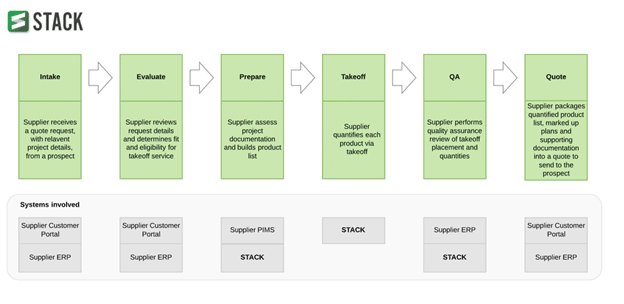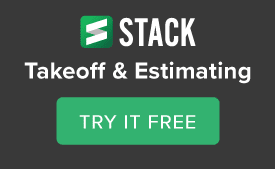Overview
Introduction
Getting Started
Develop & Launch
Support
Introduction
Integration Uses
The STACK API allows you to connect STACK directly to other software solutions, creating a seamless workflow customized for your business needs.
Integrations can be used to pull project plans and documents, directly from the construction project document or bid management solution, into STACK for the take-off and estimating process.
They can also be used to push estimate data to project accounting and project management software solutions.
This means better project tracking, clearer data analysis, reduced manual entry, and less rework.
Core capabilities include creating project and plans, creating takeoffs lists, managing items and assemblies, retrieving quantities and costs, and downloading plans.
Only API calls published in the STACK Developers Reference are supported. Customers implementing non-published API end points use at their own risk.
Move Data Across Platforms
Automate data imports and exports for real-time data integration.
Automate Business Workflows
Save time and increase accuracy by eliminating manual data entry.
Gain Important Strategic Insight
Gain knowledge through shared data reporting and dashboards.
Integration Types
Custom Integration – For Your Company Use Only
A Custom Integration is a connection between your STACK account, that you use and control, and another system used within your business.
These are typically created by STACK customers to make their team more efficient and effective by automating data movement and manual workflows between STACK and the other system.
Only you and your team will have access to your Custom Integration.
Partner Integration – For All STACK Users
A Partner Integration is typically created by another technology company to connect their application to STACK for the benefit of our mutual customers.
These integrations may be listed on the STACK Marketplace so they’re available to the entire STACK community.
Checkout the current partners and integrations.
Sample Integration Workflow
Before beginning development, it helps to plan out each step of your proposed integration workflow and list what data will be moving between the associated systems at each step.

Requirements
Creating an integration with the STACK API requires programming that is not performed by STACK.
You must be at least an entry-level software programmer with a basic understanding of programming languages, software interfaces, OAuth authorization, APIs, and web development concepts to use the API.
If you aren’t a programmer or don’t have to have a programmer on staff, you can contract the programming work to a third party.
You do need to be a STACK customer with an API Enabled Subscription to gain API access.
If you are not currently a customer, but are interested in creating a Partner Integration, please contact us to discuss your proposed integration and options.
Getting Started
Request API Access
The first step to create an integration with the STACK API is to request API access.
You do need to be a STACK customer with an API Enabled Subscription to gain API access.
If you are not currently a customer, but are interested in creating a Partner Integration, you can still request access to start the discussion about what you would like to create and how to become a partner.
In either case, simply Request API Access by completing and submitting the request form.
Our team will review the request and respond within two business days to setup an API kick-off call to discuss your proposed integration and workflow.
After the kick-off call, if you’re approved to move forward, we’ll email instructions on how to set up a Partner Account to get API credentials.
Partner Account and Credentials
To build an integration with STACK, you need a Partner Account. This is a STACK account that will be linked to your API credentials.
Even if your integration connects directly to a customer account and does not put any data into the Partner Account, a Partner Account is required for logging purposes.
You will initially create a Partner Account in the Partner Acceptance Testing (PAT) environment. (You will need to create another account when moving to the STACK production environment.)
We’ll email instructions to create a Partner Account after the API kick-off call.
Once you create the account, let us know the email address you used and we’ll send an encrypted email with the API credentials – partner user id and secret – needed to access our sandbox/Partner Acceptance Testing (PAT) environment.
Authentication
Any time you make a request to the STACK API, you must be authorized through STACK’s Authorization Server.
You need to understand the authorization process and work through the authentication steps before starting work with the API.
OAuth 2.0 - Two-Legged Authorization
Two-Legged authorization is used when your integration is writing data into or reading from an account that you control. This is typically server-to-server communication where you may create Project, Plans, Files directly into your own account.
OAuth 2.0 - Three-Legged Authorization
Three-Legged authorization is used when your integration is writing data into or reading from an account on behalf of a user. This requires the user to grant your integration permission to control his or her data. Your application will request to control a user’s account and he must click a button to grant your application the appropriate permissions.
Develop & Launch
Test Environment
You’ll build and test your integration in test environment.
This allows you to populate test data and verify that all your API calls are working as intended before connecting to the STACK production environment.
All integrations must be certified in the test environment by STACK before moving to the production environment.
If you don’t already have access, refer to the Request API Access section as the first step.
NOTE: You can find tutorials for common integration features in the Tutorials section of this site.
All API documentation is available in the API Reference.
Certification
All integrations must be certified by STACK before moving to the production environment.
This ensures that the implemented API works as expected, provides a secure and predictable interaction, and can be supported by STACK in the future.
The certification process takes about 2 hours – you’ll follow a normal business workflow while we monitor the API usage.
Once the certification is complete, you’ll be sent the results:
- • If the integration passed, you’ll receive instructions on how to move to the production environment.
- • If the integration failed, you’ll receive a list of mandatory items to be fixed, as well as optional items to improve the efficiency of the integration. Once the mandatory items have been fixed, we can repeat the certification process.
Production Environment
Once your integration has passed the certification process, we’ll email instructions to create a production partner account so you can move to the production environment.
With your production account email STACK will create your account and distribute your OAuth Client Id to you. You will then be able to reset your OAuth Client Secret when you need it.
At that point, you’re ready to go live. Congratulations!
Branding
Not all integrations require branding, but if and when you do represent STACK on your site, please refer to these brand guidelines:
- • The name STACK should always be all uppercase.
- • The STACK logo should not be manipulated or distorted in any way.
- • Minimum size for STACK logo on screen is 80px wide.
- • The STACK brand font is Proxima Nova. It is the preferred font but not required. If not using Proxima Nova, make sure to use a web-safe Sans Serif font like Arial, Helvetica, etc.
When redirecting a customer to STACK from your app, a banner or button like one of these may be appropriate:



We will provide you with the logo file and colors used in the button examples.
Support
We want your connection to the STACK API to be as seamless as possible.
If you have any questions, please email apihelp@stackct.com. (Make sure to include your name and STACK username in the email.)
© STACK Construction Technologies. All Rights Reserved
9999 Carver Road | Suite 300 | Cincinnati, OH 45242

